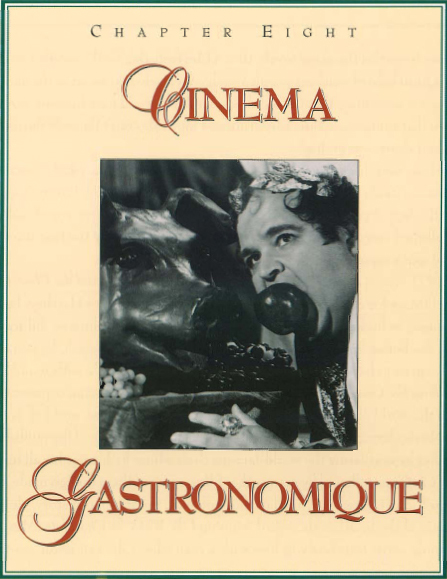

If one picture is worth a thousand words, then a film featuring food is worth a million culinary fantasies. The delight of watching people indulge themselves as we sit in the dark and munch on our popcorn is something that the big cheeses in Hollywood have become very much aware of. They know that romance, action-adventure and musicals aren’t the only things that lure the public into their shiny new multiplexes.
There have been films that used food for comedy as far back as Mack Sennett’s Keystone Kops with their custard pie obsession. Later, in Public Enemy (1931), Jimmy Cagney applied a grapefruit to the face of poor Mae Clarke. It was Jimmy’s rather violent way of making sure that she had her allotted amount of vitamin C for the day, and probably the first time that a citrus fruit was used as a weapon.
The 1971 screen adaptation of Roald Dahl’s Willie Wonka and the Chocolate Factory is a toothsome fantasy for chocoholics of any age–better than a trip to Hershey, Pennsylvania.
As audiences became more sophisticated in their eating habits, so did food images on film. One of the better-known examples of the food-film genre (which, by some odd coincidence, just happens to have been taken from a novel by your humble author and her husband) is who is Killing the Great Chefs of Europe? (1978). Its central theme is preoccupation with food, both in the world of haute cuisine and the not-so-haute-cuisine world of fast-food factories. Robert Morley brought his not inconsiderable talents to the role of the publisher who finds he can only diet by murdering the world-famous chefs whom he blames for all his problems.
Great Chefs was followed by many other films, some of them foreign made, that use food as a metaphor for lust, greed, sex, and last, but not least, the star of our story, gluttony. One of the more erotic of the bunch is the award-winning Like Water for Chocolate (Mexico 1991), in which the family cook, hopelessly in love with a man whom she can never marry, shows her devotion by creating extravagant dishes to seduce him. It’s her delectable way of making love.
Another erotic food fight, one that ends with more spilled than milk, is The Cook, the Thief, His Wife and Her Lover (England and France, 1989). At La Hollandaise Restaurant, there is nonstop gluttony from dusk till dawn, and the menu features murder, sex, revenge and a pretty decent rack of lamb. Of all the silver screen’s valentines to the food aficionado, none is as heartwarming and hilarious as Big Night (United States, 1997), which is about two bumbling brothers who open a restaurant on a dream and not much more.
MORE FOOD FLICKS

LA GRAND BOUFFE: This could almost be called a porno flick about food and depravity. Its orgiastic detail both shocks and rivets. The main characters lock themselves away to eat without restraint, to death, one might say. It takes a strong stomach to view this one.
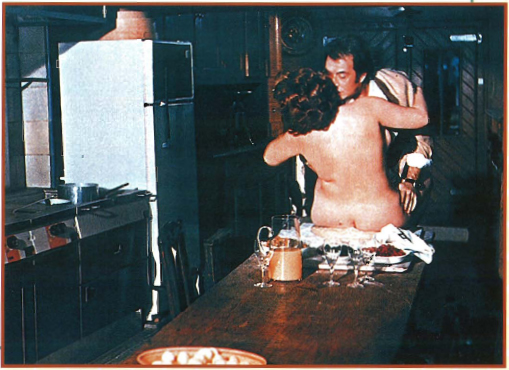
FILM STILLS ARCHIVE, MUSEUM OF MODERN ART, NEW YORK
TOM JONES: This wonderfully bawdy movie (based on the Henry Fielding 19th-century novel) of the adventures of irrepressible, captivating Tom, sports great eating scenes. In the pièce de no résistance, Tom (played by Albert Finney) sits across the table from his conquest-to-be, lasciviously savoring a ripe pear between tongue and teeth. During other Tony Richardson-directed bites, both beef and poultry are more kinetically devoured than they have been before or since in movieland. (Woodfall/United Artists-Lopert, 1963)
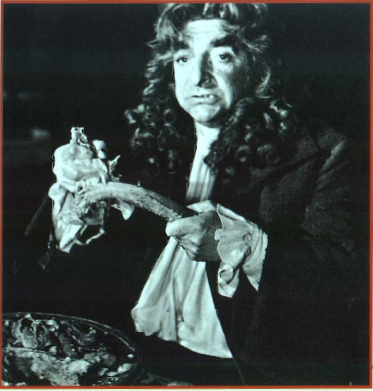
FILM STILLS ARCHIVE, MUSEUM OF MODERN ART, NEW YORK
BABETTE’S FEAST: In this extraordinary film, based on an Isak Dinesen story, a passionate French cook wins the lottery. After years of having lived among people to whom food represents only basic nourishment, she creates a superb meal which awakens them to the artistry of her soul. (Panorama/Nordisk/Danish Film Institute, 1987)
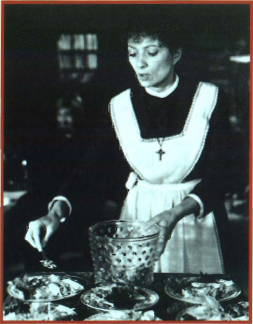
FILM STILLS ARCHIVE, MUSEUM OF MODERN ART, NEW YORK
LITTLE SHOP OF HORRORS: The first film of this bizarre story was directed by Roger Corman in 1960; the Technicolor remake, which appeared in 1986, incorporates tunes from a play based on the Corman movie. In all versions, the leafy tale stars a delightfully carnivorous plant named Audrey.
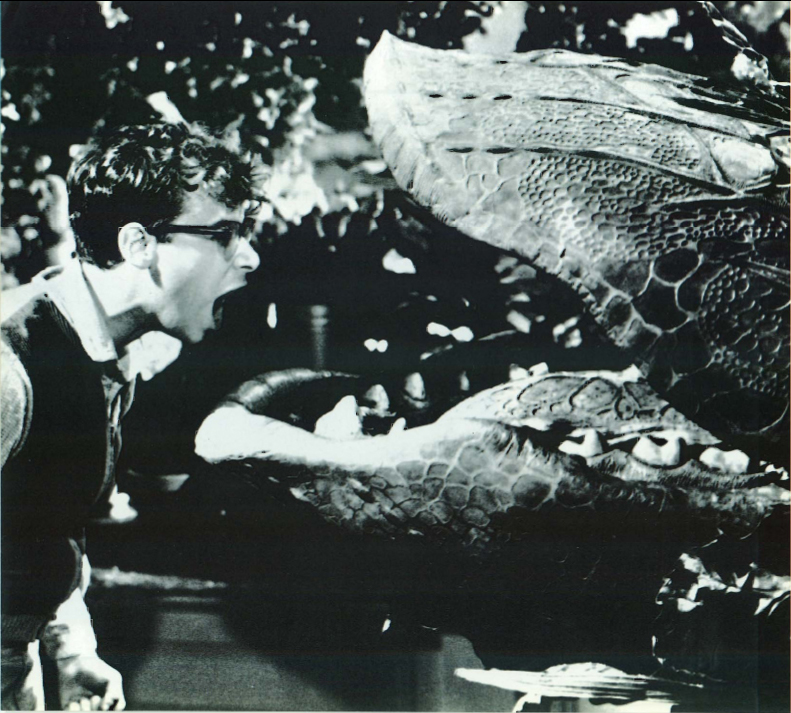
Hollywood stars lead bits of their lives as we do. Heather Locklear likes to swing by Taco Bell more often than she would have it known. Liv Tyler and Ashley Judd are French fry fanatics. Jennifer Love Hewett prefers classic Coke to Lala Land’s mineral water. Matt Damon’s X-rated snack is chocolate cake, while Winona Ryder eats enough Eskimo Pies to rate her own igloo.

HISTORY OF THE WORLD, PART I: In Mel Brooks’ glorious satire of ancient Rome, Dom Deluise does a hilarious take on Emperor Nero. Will the real pig please stand up? (Brooksfilms, 1961)

FILM STILLS ARCHIVE, MUSEUM OF MODERN ART, NEW YORK
ROAST SUCKLING PIG
1 (approximately 18-lb.) suckling pig |
2 tablespoons salt |
2 tablespoons olive oil |
2 teaspoons freshly ground pepper |
6 garlic cloves, smashed |
2 quarts ginger ale |
2 tablespoons chopped fresh rosemary |
1 large red apple (optional) |

Preheat oven to 450 degrees.
Rub olive oil all over the pig. Slip underneath the skin garlic, rosemary, salt and pepper. Rub some of the herb mixture inside the cavity, too. If you are going to serve the pig with an apple in its mouth, use a large wad of foil to hold the pig’s mouth open during roasting.
Place pig on a rack in a roasting pan and cover loosely with foil. Roast for 1 ½ hours, then uncover the pig. Pour about 2 cups of ginger ale over the pig and continue roasting for about another hour. Baste whenever the liquid begins to dry up, and again during the last 15 minutes of roasting. (All the ginger ale may not be necessary.) If the pig appears to be browning too quickly, turn heat down to 425 degrees.
The pig is done when it is well-browned and a leg wiggles easily at the joint or when a meat thermometer, inserted in its thigh away from a bone, registers 160 degrees.
If presenting the pig with apple in mouth, remove foil from its mouth and insert apple. Makes 10-12 servings of pork.

TOM JONES FRIED CHICKEN
This fried chicken is juicy and crisp, but not loaded with breading.

1 chicken, cut into 8 pieces |
2 teaspoons salt |
1 quart buttermilk |
1 ½ teaspoons freshly ground black pepper |
Tabasco or fresh lemon juice |
1 pound pure lard |
1 cup all-purpose flour, approximately |
|

Place chicken in a stainless-steel, glass, enamel or ceramic dish and cover with buttermilk. (You may not need all the buttermilk.) Add several drops of Tabasco or juice of 1 lemon. Cover. Let chicken marinate in refrigerator for at least 1 hour, or as long as 8.
Remove chicken and use paper towels to pat off excess buttermilk.
Using a fork, combine flour, salt and pepper in a shallow dish or pie plate. Dredge each piece of chicken in flour, coating thoroughly.
Melt lard in a cast-iron skillet (you may not need the whole pound but the melted lard should be about an inch deep in the skillet); heat until almost smoking. Do not crowd the skillet when you place chicken pieces in it. Brown the chicken pieces at high heat. Watch chicken carefully and adjust heat to keep skin from burning. Turn and brown the other side of each portion. Remove pieces as they are browned.
Return all chicken to the pan; if all the pieces will not fit in your skillet, layer them in so dark meat is on the bottom and white meat is on the top. Partially cover skillet. Cook 15-20 minutes until chicken is done, but still juicy. Makes 4 servings.